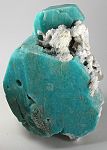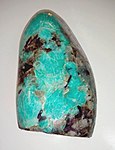Amazonite
| Amazonite | |
|---|---|
Radioactive 14.05% (K) | |
| References | [1][2][3]:214–215 |
Amazonite, also known as amazonstone,
Its name is taken from that of the Amazon River, from which green stones were formerly obtained, though it is unknown whether those stones were amazonite.[4] Although it has been used for jewellery for well over three thousand years, as attested by archaeological finds in Middle and New Kingdom Egypt[8] and Mesopotamia, no ancient or medieval authority mentions it. It was first described as a distinct mineral only in the 18th century.[9]
Green and greenish-blue varieties of potassium feldspars that are predominantly triclinic are designated as amazonite.[10] It has been described as a "beautiful crystallized variety of a bright verdigris-green"[11] and as possessing a "lively green colour".[4] It is occasionally cut and used as a gemstone.[12]
Occurrence
Amazonite is a mineral of limited occurrence. In Bronze Age Egypt, it was mined in the southern Eastern Desert at Gebel Migif. In early modern times, it was obtained almost exclusively from the area of Miass in the Ilmensky Mountains, 50 miles (80 km) southwest of Chelyabinsk, Russia, where it occurs in granitic rocks.[4]
Amazonite is now known to occur in various places around the globe. Those places are, among others, as follows:
Australia:
- Eyre Peninsula, Koppio, Baila Hill Mine (Koppio Amazonite Mine)[13]
China:
- Baishitouquan granite intrusion, Hami Prefecture, Xinjiang: found in granite[14][15]
Libya:
- Jabal Eghei, Tibesti Mountains: found in granitic rocks[16]
Mongolia:
- Avdar Massif, Töv Province: found in alkali granite[10]
South Africa:
- Mogalakwena, Limpopo Province[17]
- Khâi-Ma, Northern Cape[17]
- Kakamas, Northern Cape[17]
- Ceres Valley, Western Cape[17]
Sweden:
- Skuleboda mine, Västra Götaland County: found in pegmatite[18]
United States:
- Colorado:
- Deer Trail, Arapahoe County[3]:233
- Custer County[3]:234
- Devils Head, Douglas County[3]:234
- Pine Creek, Douglas County[3]:234
- Crystal Park, El Paso County[3]:234
- Pikes Peak, El Paso County: found in coarse granites or pegmatite[4]
- St. Peter's Dome, El Paso County[3]:234
- Tarryall Mountains, Park County[3]:235
- Crystal Peak, Teller County[3]:235
- Wyoming
- Virginia:
- Morefield Mine, Amelia County: found in pegmatite[19]
- Rutherford Mine, Amelia County[19]
- Pennsylvania:
- Media, Delaware County[3]:244
- Middletown, Delaware County[3]:244
Color
For many years, the source of amazonite's color was a mystery.[20] Some people assumed the color was due to copper because copper compounds often have blue and green colors.[20] A 1985 study suggests that the blue-green color results from quantities of lead and water in the feldspar.[20] Subsequent 1998 theoretical studies by A. Julg expand on the potential role of aliovalent lead in the color of microcline.[21]
Other studies suggest the colors are associated with the increasing content of lead, rubidium, and thallium ranging in amounts between 0.00X and 0.0X in the feldspars, with even extremely high contents of PbO, lead monoxide, (1% or more) known from the literature.[10] A 2010 study also implicated the role of divalent iron in the green coloration.[7] These studies and associated hypotheses indicate the complex nature of the color in amazonite; in other words, the color may be the aggregate effect of several mutually inclusive and necessary factors.[9]
Health
A 2021 study by the German Institut für Edelsteinprüfung (EPI) found that the amount of lead that leaked from an 11 g (0.39 oz) sample of Amazonite into an acidic solution simulating saliva exceeded European Union standard DIN EN 71-3:2013's recommended amount by five times. This experiment was to simulate a child swallowing Amazonite, and could also apply to new alternative medicine practices such as inserting the mineral into oils or drinking water for days.[22]
Gallery
-
Deep robins-egg blue color amazonite crystal on smoky quartz and albite, from Teller County, Colorado. Size: 3.4 cm × 3.3 cm × 2.5 cm (1.3 in × 1.3 in × 1.0 in).
-
Large deep-turquoise amazonite crystal with attached stark-white microcline, fromKonso, SNNPR, Ethiopia. Size: 16.4 cm × 11.9 cm × 8.0 cm (6.5 in × 4.7 in × 3.1 in).
-
Two smoky quartz crystals surrounded by amazonite crystals, from Smoky Hawk Mine, Crystal Peak, Teller County, Colorado. Size: 11.0 cm × 8.2 cm × 6.3 cm (4.3 in × 3.2 in × 2.5 in).
-
Amazonite crystals onKonso, SNNPR, Ethiopia.
-
Deep lustrous crystal of amazonite, from Take 5 Claim, Crystal Peak, Teller County, Colorado. Size: 4.4 cm × 4.0 cm × 3.5 cm (1.7 in × 1.6 in × 1.4 in).
-
Amazonite from the Landsverk 1 mine with the livery collar of the mayor of Evje, Norway. Size: 21 cm × 22 cm (8.3 in × 8.7 in).
-
Amazonite partly altered to brown microcline from the Landsverk 1 mine in Evje, Norway.
-
Polished Amazonite specimen. Height 13 cm (5 in).
References
- ^ ISBN 0806994614 – via Internet Archive.
- ^ "Radioactive Gems : ClassicGems.net". ClassicGems.net. Archived from the original on 2021-02-11. Retrieved 2021-08-13.
- ^ a b c d e f g h i j k Schlegel, Dorothy McKenney (1957). "Gem Stones of the United States". Geological Survey Bulletin (1042-G). United States Government Publishing Office – via Google Books.
- ^ a b c d e f One or more of the preceding sentences incorporates text from a publication now in the public domain: Chisholm, Hugh, ed. (1911). "Amazon-stone". Encyclopædia Britannica. Vol. 1 (11th ed.). Cambridge University Press. p. 791.
- ^ "Amazonite gemstone information". gemdat.org. Archived from the original on 2021-03-01. Retrieved 2018-08-24.
- ^ "Amazonite".
- ^ a b "Amazonite: Amazonite mineral information and data". mindat.org. Archived from the original on 14 May 2021. Retrieved 13 April 2017.
- ^ Harrell and Osman 2007
- ^ a b Mikhail Ostrooumov, Amazonite: Mineralogy, Crystal Chemistry, and Typomorphism (Elsevier, 2016), p. 1–12.
- ^ .
- ^ Chisholm, Hugh, ed. (1911). . Encyclopædia Britannica. Vol. 18 (11th ed.). Cambridge University Press. p. 380.
- ^ "Common Minerals of Virginia". Virginia Department of Mines, Minerals and Energy. Commonwealth of Virginia. Archived from the original on 24 July 2021. Retrieved 5 July 2019.
- ^ "Barnes L. C., et al, (1980), Some Semiprecious and Ornamental Stones of South Australia, Government Printer, Adelaide, South Australia".
- (PDF) from the original on 2022-10-09.
- ISSN 1000-0569.
- S2CID 26947582.
- ^ a b c d "Amazonite from South Africa". www.mindat.org. Retrieved 2020-05-25.
- ^ Lundegårdh, Per H. (1971). Nyttosten i Sverige (in Swedish). Stockholm: Almqvist & Wiksell. p. 21.
- ^ a b Penick, D. Allen Jr.; Sweet, Palmer C. (May 1992). "Mineral collecting sites in Virginia" (PDF). Virginia Minerals. 38 (2). Charlottesville, Virginia: Virginia Department of Mines, Minerals, and Energy: 10–12. Archived from the original (PDF) on 24 April 2012.
- ^ a b c Hoffmeister and Rossman (1985). "A spectroscopic study of irradiation coloring of amazonite; structurally hydrous, Pb-bearing feldspar" (PDF). American Mineralogist. 70: 794–804. Archived (PDF) from the original on 2022-10-09 – via Mineralogical Society of America.
- S2CID 95011489.
- ^ "Lead in Amazonite – Caution". Institut für Edelsteinprüfung. April 22, 2021. Archived from the original on March 7, 2021. Retrieved August 13, 2021.
Further reading
- Perl, Richard M. (1972). Colorado Gem Trails: And Mineral Guide. Swallow Press. ISBN 978-0-8040-0956-0.
External links
![]() Media related to Amazonite at Wikimedia Commons
Media related to Amazonite at Wikimedia Commons









